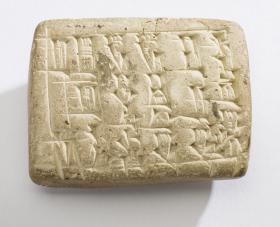The tablet of Sin-Kasid, King of Uruk
Students will investigate the emergence of writing and come to a greater understanding of the defining characteristics of the ancient civilisation of Sumer through an investigation of evidence provided in a cuneiform from c.1860 BCE.
Key inquiry question #1
How do we know about the ancient past?
Key inquiry question #2
What emerged as the defining characteristics of ancient societies?
Key inquiry question #3
What have been the legacies of ancient societies?
Content
The range of sources that can be used in an historical investigation, including archaeological and written sources (ACDSEH029)
Students:
- list a range of sources used by archaeologists and historians in historical investigations
Background Information for Teachers
Learning intention
Students are learning:
- To understand the types of evidence used by historians investigating ancient societies
- To recognise the important legacies of ancient societies in shaping the modern world
Success criteria
Students will be successful when they can:
- Outline defining characteristics of the ancient Sumerian society through an analysis of the historical evidence
- Describe the technological development of writing from its birth with the ancient Sumerians of Mesopotamia
The State Library of NSW’s Cuneiform
The State Library of NSW has one tablet in its Special Collections. According to the records of the then Principal Librarian, William Herbert Ifould, O.B.E., the tablet was donated in 1940 by a Mr J. Yared who had previously migrated to Australia from Syria. At the time of the cuneiform’s donation, it was thought to be a replica. However, separate inspections in 1975 and 1983 correctly identified that the tablet was a genuine artefact from c. 1860 BCE. The inscription, written in Sumerian, provides evidence that the artefact dates from the rule of Sîn-kāšid, King of the city of Uruk, located in the south of modern-day Iraq. The tablet was baked in antiquity, which was a critical factor in its current excellent state of preservation.
The inscription records the king’s name, titles and epithets, and states he built a royal palace.
There are many other known exemplars of this inscription, recorded on a variety of objects, including bricks and clay cones as well as other tablets. These objects were recovered from the foundations of Sîn-kāšid’s palace at Uruk where they served as foundation deposits, placed on every fourth course of bricks during construction. The reason this was done was to ensure that when the mud-brick palace needed renovation over the future centuries, Sîn-kāšid’s name and deeds would be read by his successors and his legacy would survive.
Interesting points regarding the inscription
Line 4 states that Sîn-kāšid was also the leader of the Amnanum tribe. This era of Mesopotamian history is dominated by military styled Amoriate tribes who infiltrated and ruled a number of cities. It seems Sîn-kāšid’s rise to power should be seen in this light.
Line 5, Sîn-kāšid is described as the “provider for E-anna” (or “House of Heaven”) which was the major temple of Anu and Inanna/Istar in Uruk. The mention of this important temple here also suggests that this tablet originated in Uruk.
(Notes and translation courtesy of L. R. Siddall)
Student Activities
Unravelling the development of writing
Students interrogate an ancient Sumerian cuneiform tablet from the collections of the State Library of NSW and investigate the technological development of writing through history.

NSW Syllabus for the Australian Curriculum History K-10
A student:
- HT4-5 identifies the meaning, purpose and context of historical sources
- HT4-6 uses evidence form sources to support historical narratives and explanations
Analysis and use of sources
- identify the origin and purpose of primary and secondary sources (ACHHS209, ACHHS152)
Empathetic understanding
- interpret history within the context of the actions, attitudes and motives of people in the context of the past (ACHHS212, ACHHS155)
Explanation and communication
- develop historical texts, particularly explanations and historical arguments that use evidence from a range of sources (ACHHS213, ACHHS156)
Continuity and change: some aspects of a society, event or development change over time and some remain the same
Learning across the curriculum
- Personal and social capability
- Work and enterprise